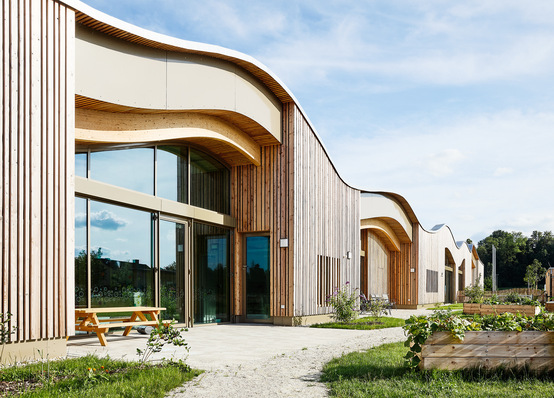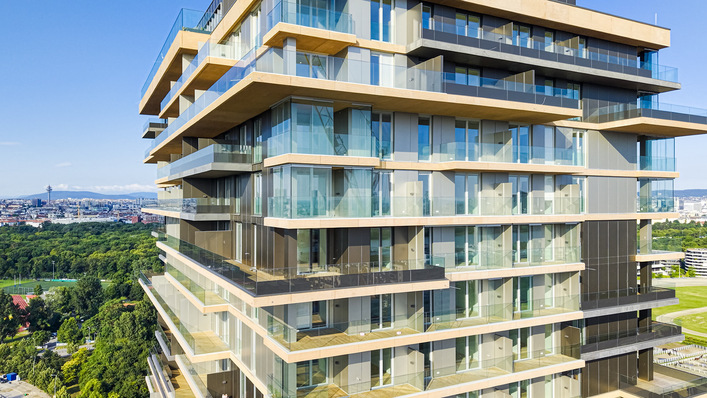The effectiveness was still low, but even the early attempts at bird protection on glass surfaces fulfilled two of today's criteria: Making a barrier visible and preventing deceptive reflections (e.g. from trees). The former means that the obstacle is indicated as such to the bird on the outside of the transparent surface, which it recognises as impassable. The latter means that the reflection is interrupted by an object and the reflection of trees or the sky is less attractive for the bird to fly there.
Thomas Rainer has been working with bird protection glass since 1995. He is the authorised signatory and head of development at Hegla boraident, the supplier of laser systems from the Hegla Group (www.hegla.com). Since Dr. Rainer had written his doctoral thesis on processing glass with a laser, the idea of implementing a bird protection function in the glass via laser was obvious to him. "Thanks to the precision of the laser, the processing can be carried out without damaging the surface," explains Dr. Rainer.
Protective pattern at position 1 makes approach unattractive
"We wanted to take advantage of the properties of the glass pane," says Rainer, "by using the existing coating for the bird protection glass." The spot processing of the thermal protection layers on position 2 has resulted in a pattern that, adapted to the wing span width of most songbird species, makes the fly-through appear impossible.
See also: Hegla boraident: Unique marking and identification for windows and doors
Overall, good protection could be achieved with this method. "However, scientific knowledge has changed in recent years to the effect that the protective function should take place on position 1 of the facade glass (i.e. on the outside)," explains Rainer.

Boraident
The reasons for this lie in the reflective properties of the glass surface. Depending on the position of the sun and the mirrored environment, the interaction of all factors can result in the structure on the inside of the window not being visible to the bird and the effectiveness of a bird protection structure on position 2 being temporarily reduced.
In the patented laser printing process of Hegla boraident, the functional structures are therefore applied to the outside (position 1).
Basically, finishing is a balancing of different interests. "Architecturally, glass is used to bring as much light as possible into the room and to create the impression of openness to the surroundings. For the bird, this is precisely what becomes a danger, in that it cannot perceive the surface," says Thomas Rainer.
All the more reason, he says, to bring these demands into a suitable relationship with a transparent print. The finishing is done in the form of semi-transparent dots with a diameter of 5 to 9 mm and a spacing of 50 to 100 mm.
Also interesting: Schüco Carbon Control – What is it all about?
In order to meet the special requirements of position 1, these are light and colour fast as well as scratch and weather resistant. If the imprint is instead desired as a visible design element, it can be made partially or completely opaque.
Both variants have one thing in common: as a first protection criterion, flying through is indicated as impossible at position 1. As a second factor, the reflection of the glass is discreetly interrupted and the reflection is adjusted in such a way that an animal eye receives a further warning signal.
Scratch-resistant, light- and colour-fast dots with modified reflection
Basically, finishing is a balancing of different interests. "Architecturally, glass is used to bring as much light as possible into the room and to create the impression of openness to the surroundings. For the bird, this is precisely what becomes a danger, in that it cannot perceive the surface," says Thomas Rainer.
All the more reason, he says, to bring these demands into a suitable relationship with a transparent print.
The finishing is done in the form of semi-transparent dots with a diameter of 5 to 9 mm and a spacing of 50 to 100 mm. In order to meet the special requirements of position 1, these are light and colour fast as well as scratch and weather resistant.
If the imprint is instead desired as a visible design element, it can be made partially or completely opaque.
Both variants have one thing in common: as a first protection criterion, flying through is indicated as impossible at position 1. As a second factor, the reflection of the glass is discreetly interrupted and the reflection is adjusted in such a way that an animal eye receives an additional warning signal.
Scattering as an additional output feature

Boraident
As a third factor, the laser function print also alters the light scattering and provides protection in the range of both UV and visible light, making the approach unattractive.
For humans, the dots or pattern are barely perceptible as they are semi-transparent. "It was all the more important for us to scientifically prove the effectiveness of our bird protection structure," explains Thomas Rainer.
Last year, the supplier of laser systems therefore decided to have various glasses with different coatings and bird protection patterns tested at the American Bird Conservancy in the USA. Thread factors" between 13 and 27 were achieved. A value of 30 or less is required to be classified as bird protection glass.
Did you miss this? "Glass bans for bird protection make no sense"
The test is required by law in the USA. In Germany, there are no specifications in this regard. However, it is becoming increasingly important, especially for architects, to be able to prove the sustainability of their buildings.
Bird protection structure on float glass, ESG, LSG and ISO
With the laser process of Hegla boraident, float glass, LSG, ESG panes as well as insulating glass can be refined at every stage of production as individual pieces or in series. "Many of our customers print a bird screen at the end of the production process. This means that this production step is independent of the glass flow and can also be carried out subsequently," emphasises Thomas Rainer.
The processing is done with the Laserbird laser system, which also allows for further refinements, e.g. to a mobile-radio-permeable glass.














